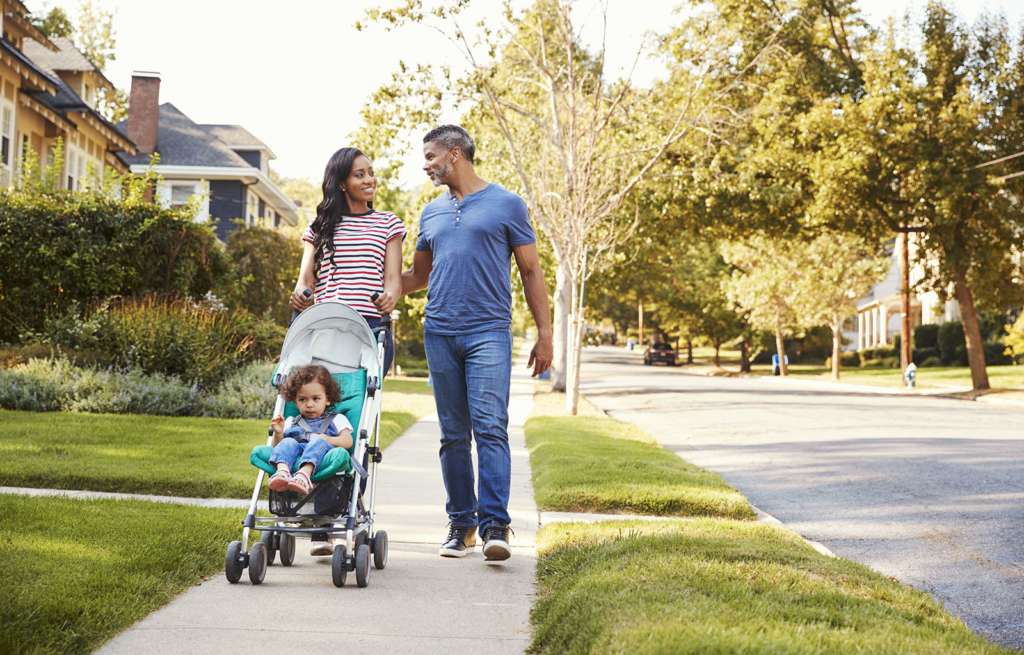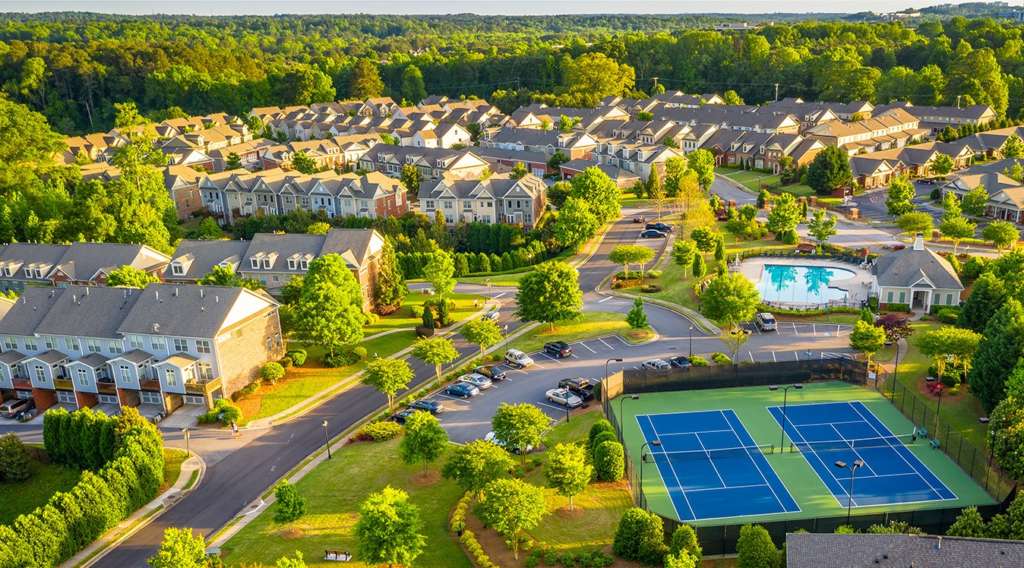If you’re a prospective homebuyer, you may find yourself debating the appeal of life in a gated community. Like so many questions you’re likely facing, this one is complicated and hinges a good deal on personal preference – but we can help you get started by defining what this type of community actually is.
A gated community is just what it sounds like: any collection of homes that limits access to residents and their guests through the use of a physical barrier – whether a gate, wall, fence or some combination of those. Gates may be staffed by security personnel or may open automatically for residents through the use of key cards, remote controls, or other means, but the central point is that the general public cannot wander in uninvited.
Though gated communities are often associated in pop culture with suburbia, they can exist in any location, no matter how urban or rural. The residences within are often new construction homes consisting of single-family homes, condominiums, apartments, or co-ops, and can range from a few residents to several thousand.
Gated Community Features
When evaluating different aspects of gated communities, it’s important to remember that what seems like an advantage to one person could seem like a disadvantage to another. Gated communities can also vary widely from one to the next.
That said, there are a few key traits that are commonly associated with gated communities. Let’s take a closer look at each one.

Security and Safety
For many residents, the most obvious advantage to a gated community is security. As we mentioned earlier, community gates may be staffed with guards or may open with the use of technology, including key cards, remote controls, and security codes. Some may also be augmented with video surveillance or guards patrolling the neighborhood.
There is little scientific consensus on the extent to which gated communities reduce crime. A 2013 study published in The Oxford Handbook of Environmental Criminology found that gated communities experienced 33% fewer burglaries than non-gated communities, but a different study from the University of South Florida the previous year found that a gated community appeared to have little effect on burglaries. Researchers have also barely scratched the surface regarding the rates at which gated communities experience other kinds of crime, or the extent to which they might drive criminal activity into surrounding, often lower-income neighborhoods.
That said, even if their statistical effect on crime rates is nominal, gated communities still bring a perception of safety for the residents – which might be particularly useful in neighborhoods that were low-crime to begin with. As with any other private property, entering a gated community uninvited is illegal, but having a physical barrier to your neighborhood can provide more emotional reassurance than reading up on local trespassing laws. The reality is that gating a community is not a panacea, but one tool of many in a property manager’s toolbox.
All of that said, safety is about much more than keeping trespassers out. Given the limits on cars entering and leaving, gated communities are not only relatively quiet, but generally have much less through traffic than un-gated ones, which can make it safer for children to play outside, and for older residents to take a walk. This aspect can be particularly useful to parents of young children, or multi-generational homes. That said, this same benefit can also be a hazard, as the security precautions in a gated community can slow down emergency personnel like ambulances, police, and firefighters.

Privacy and Community
No matter what the neighborhood’s surrounding area is like, gated communities bring a promise of privacy and tranquility that can be enormously appealing to many would-be residents. Those who’ve become accustomed to life in bustling urban areas may see a gated community as just the peaceful oasis they’ve been looking for – where traffic is quiet, they won’t have solicitors knocking on their door, and even shared facilities are only shared by so many people.
Alongside this sense of privacy, these neighborhoods can also foster a real sense of warmth and community. In contrast to heavily populated areas where residents may never get to know their neighbors, having fewer people in your neighborhood can make it easier to recognize, trust, and befriend one another – not to mention community events arranged for the residents, like picnics, movie nights, holiday festivals, and more.
Of course, as with almost every aspect of a gated community, there are two sides to the coin: Where one person sees privacy and belonging, another might see enclosure and isolation. This type of neighborhood may feel stifling for residents who would prefer to have friends and family drop in at any time, and to host parties without needing to submit event hours and guest lists to security ahead of time.
On a bigger scale, life inside the gates can also leave some residents feeling closed off from the wider cultural community in which they live. The fees associated with gated communities (which we’ll get to below) can have also the effect of grouping people of the same socioeconomic status together, and leaving others out.
Rules and Regulations
As with any neighborhood governed by an HOA, gated communities bring several rules and regulations – the appeal of which is often subjective. For instance, HOAs often enforce standards regarding home exteriors; and where one resident might enjoy a neighborhood with a cohesive aesthetic and no chipping paint, another resident might feel that such regulations stifle their individuality.
Aside from the security measures we’ve discussed above, some common gated community regulations include the following:
- Exterior home appearance requirements (ranging from paint colors to garden tool brands to the height of your grass)
- Long-term storage allocations
- Regulations on parking and vehicles (for instance, many HOA regulations prohibit RVs from being parked in driveways)
- Restrictions on signage, landscaping, and holiday decorations
- Limits on pet quantity and size
- Noise complaint policies
- Restrictions on short-term rentals
- Home occupancy limits
It’s also worth mentioning that enforcement of these rules by the HOA – who may issue warnings, charge fines, or put a lien on your house as penalties – may be a relief to some, and irksome to others.
Gated Community Costs
Belonging to a gated community can come with a heavy price tag.
For one thing, homes in gated communities can come with a higher asking price; a 2016 study from the American Real Estate Society found that the average home in a gated community sold for $30,000 more than a comparable home in a non-gated one.
Residents will also be required to make regular payments for the upkeep of the community. As we mentioned, all gated communities are governed by HOAs, which means that residents can expect their community-related fees to start with a typical monthly, annual, or quarterly HOA fee (though, as we discussed in our HOA blog post, there’s no such thing as a “typical” HOA fee, as one HOA might charge $40 per month while another might charge thousands).
While the variation in these fees may depend on several factors, the most straightforward predictors of HOA fees are generally community size and amenities provided; and as gated communities include the additional amenity of substantial security measures (after all, the gate, security guards, and key cards all have to be paid for), their HOA fees will be higher than those of comparable non-gated communities.
As an example, while HOA fees for a non-gated community in Daytona Beach, FL may come to about $600 per year, the HOA for a similar home in a gated community may charge upwards of $2,000 over the same period. It’s also worth noting that additional expenses may be incurred by following many of the community regulations we’ve already discussed, particularly those related to home appearance, structure, and quality controls.

Amenities
While HOAs in non-gated communities may not provide any amenities at all, members of a gated community can more likely expect certain shared resources. In addition to basic services like trash removal, these communities might include a fitness center, park, landscaped grounds, swimming pool, and more; Sea Gate, an 8,000-person gated community in Brooklyn, includes a dog park and a private beach.
On top of the amenities themselves, common spaces and shared resources in these neighborhoods will typically be held to high standards and maintenance, just like the actual homes are – all of which can have the significant advantage of stabilizing or increasing home property values over time.
It’s worth noting, however, that amenities are not automatically a plus. In the same 2016 study which concluded that gated community homes sell for $30,000 more than non-gated ones, researchers found that the increase appeared to be caused by the gate (and related security measures) alone. When it came to additional community amenities, like fitness centers or pools, homes saw their sale price reduced by an average of $20,000 – which researchers pegged to perceptions that the maintenance costs of amenities may outweigh their benefits.
As with so many decisions facing potential homebuyers, the question of whether to consider a gated community largely comes down to personal preference. And if you get to the point of evaluating a particular community, it’s imperative to research specifics, whether online or with the help of your realtor. Just remember that choosing a new home isn’t just about choosing a new space, but a new way of life – and that for some, life inside a gated community may be well worth exploring.
To begin your search for a new home and community that perfectly fits your lifestyle, visit khov.com today.
Last Updated on January 18, 2022
